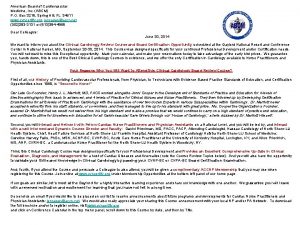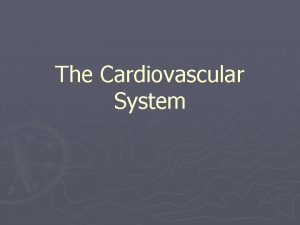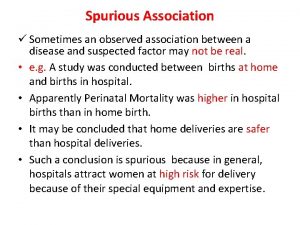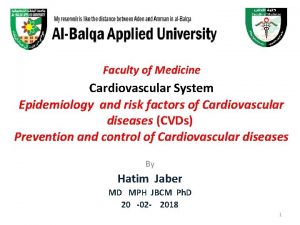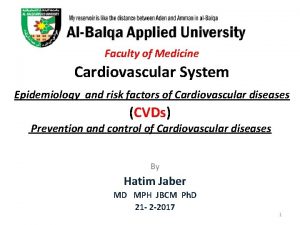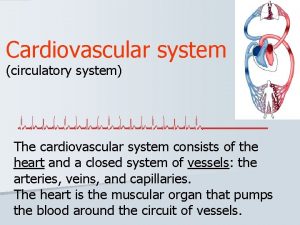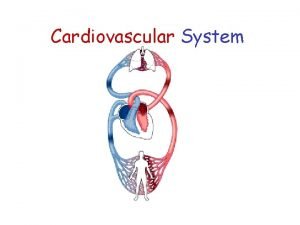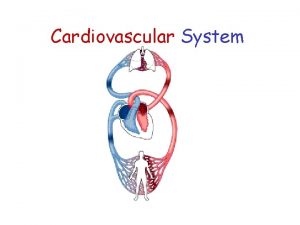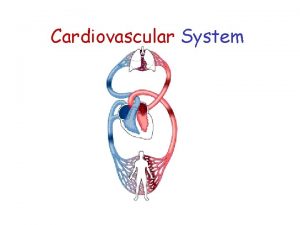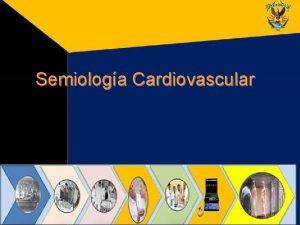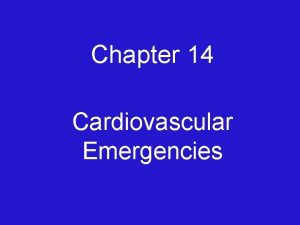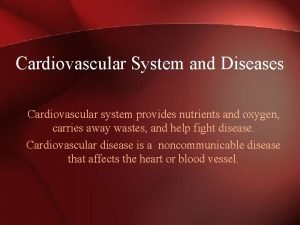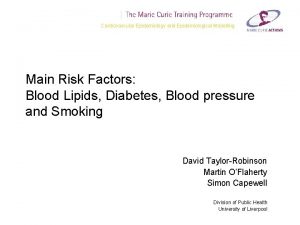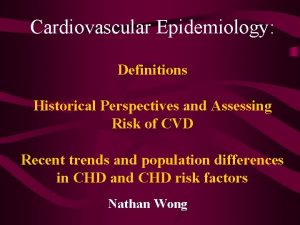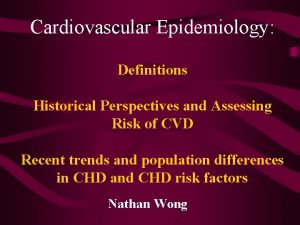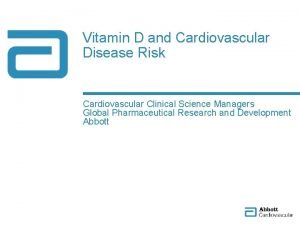Faculty of Medicine Cardiovascular System Epidemiology and risk




























































- Slides: 60

Faculty of Medicine Cardiovascular System Epidemiology and risk factors of Cardiovascular diseases (CVDs) Prevention and control of Cardiovascular diseases By Hatim Jaber MD MPH JBCM Ph. D 21 - 2 -2017 1

Presentation outline Time Introduction and Definitions of CVD 12: 00 to 12: 10 Epidemiology of CVD: globally and locally 12: 10 to 12: 30 CVD risk factors 12: 30 to 12: 50 Prevention and Control of CVD 12: 50 to 13: 15 Screening for CVD risk factors 13: 15 to 13: 40 2

What are cardiovascular diseases? Cardiovascular diseases (CVDs) are a group of disorders of the heart and blood vessels and they include: • coronary heart disease – disease of the blood vessels supplying the heart muscle; • cerebrovascular disease – disease of the blood vessels supplying the brain; • peripheral arterial disease – disease of blood vessels supplying the arms and legs; • rheumatic heart disease – damage to the heart muscle and heart valves from rheumatic fever, caused by streptococcal bacteria; • congenital heart disease – malformations of heart structure existing at birth; • deep vein thrombosis and pulmonary embolism – blood clots in the leg veins, which can dislodge and 3 move to the heart and lungs.

Definitions • CORONARY ARTERY DISEASE (CAD) or CORONARY HEART DISEASE (CHD) (often broadly referred to as ISCHEMIC HEART DISEASE (IHD): - primarily myocardial infarction and sudden coronary death, - broader definition may include angina pectoris, atherosclerosis, positive angiogram, and revascularization (perceutaneous coronary interventions, or PCI such as angioplasty and stents) 4

The different types of CVDs 1. CVDs due to atherosclerosis: • �� ischaemic heart disease or coronary artery disease (e. g. heart attack) • �� cerebrovascular disease (e. g. stroke) • �� diseases of the aorta and arteries, including hypertension and peripheral vascular disease. 2. Other CVDs • �� congenital heart disease • �� rheumatic heart disease • �� cardiomyopathies • �� cardiac arrhythmias. 5

Types of Cardiovascular Disease - Coronary heart disease (CHD, ischemic heart disease, heart attack, myocardial infarction, angina pectoris) - Cerebrovascular disease (stroke, TIA, transient ischemic attack) - Hypertensive heart disease - Peripheral vascular disease - Heart failure ? ? ? ? ? ? - Rheumatic heart disease (streptococcal infection) - Congenital heart disease - Cardiomyopathies 6

Definitions (cont. ) • SURROGATE MEASURES include: carotid intimal medial thickness (IMT), coronary calcium, angiographic stenosis, brachial ultrasound flow mediated dilatation (FMD) • Hard endpoints include: --- myocardial infarction, --- CHD death, - and stroke 7

Public Health Significance - Leading cause of mortality in developed countries and a rising tendency in developing countries (disease of civilization) - A major impact on life expectancy - Significantly contributes to morbidity and death rates in the middle aged population: - potential life years lost, - common cause of premature death, - labor force (economic costs), - family life - Morbidity: nearly 30% of all disability cases - Contributes to deterioration of the quality of life 8

Tasks of Cardiovascular Epidemiology - Detection of the occurrence and distribution of CVD in populations, surveillance, monitoring, trends of changes - Study of the natural history of CVD - Formulation and testing of etiological hypotheses (risk factors) - Contribution to the development of cardiovascular prevention programs and the measurement of their effectiveness 9

Descriptive Epidemiology I. Distribution Patterns in the World---KEY FACTS • CVDs are the number 1 cause of death globally: more people die annually from CVDs than from any other cause. • An estimated 17. 5 million people died from CVDs in 2012, representing 31% of all global deaths. Of these deaths, an estimated 7. 4 million were due to coronary heart disease and 6. 7 million were due to stroke. • Over three quarters of CVD deaths take place in low- and middle-income countries. • Out of the 16 million deaths under the age of 70 due to noncommunicable diseases, 82% are in low and middle income countries and 37% are caused by CVDs. 10

CVDs are responsible for over 17. 3 million deaths per year and are the leading causes of death in the world 11

KEY FACTS • Most cardiovascular diseases can be prevented by addressing behavioral risk factors such as: • tobacco use, • unhealthy diet and obesity, • physical inactivity • and harmful use of alcohol using population-wide strategies. • People with cardiovascular disease or who are at high cardiovascular risk (due to the presence of one or more risk factors such as hypertension, diabetes, hyperlipidaemia or already established disease) need early detection and management using counseling and medicines, as appropriate 12

Descriptive Epidemiology II. AGE Question: What is the relative amount of CVD in death rates in different age groups? - Early lesions of blood vessel, atherosclerotic plaques: around 20 years - adult lifestyle patterns usually start in childhood and youth (smoking, dietary habits, sporting behavior, etc. ) - Increase in CVD morbidity and mortality: in agegroup of 30 -44 years - Premature death (<64 years of age, or 25 -64 years): in the elderly population more difficult to interpret death rate due to multiple ill health causes 13

PROPORTION OF MORTALITY IN DIFFERENT AGE-GROUPS (MEN) 4, 7% 100% 14, 9% 90% 80% 70% 26, 0% 61, 5% 24, 6% external others cancer CVD 60% 50% 26, 9% 40% 30% 55, 8% 22, 5% 32, 7% 20% 11, 4% 10% 4, 6% 0% 1 -24 yrs 25 -64 yrs >65 yrs 14

PROPORTION OF MORTALITY IN DIFFERENT AGE-GROUPS (WOMEN) 100% 8, 2% 90% 4, 8% 18, 3% 40, 0% 24, 0% 80% 12, 2% 70% external others cancer CVD 60% 36, 5% 50% 35, 0% 40% 64, 7% 30% 20% 10% 0% 17, 7% 31, 3% 7, 3% 1 -24 yrs 25 -64 yrs >65 yrs 15

Descriptive Epidemiology III. SEX Question: What is the relative amount of CVD in death rates in women and men? - Widespread idea: CVD is often thought to be a disease of middle-aged men. - Cardiovascular mortality (fatal cases) are more common among men. However, CVD affect nearly as many women as men, albeit at an older age - Women: special case (WHO, 2004) a. , Higher risk in women than men (smoking, high triglyceride levels) b. , Higher prevalence of certain risk factors in women (diabetes mellitus, depression) c. , Gender-specific risk factors (risks for women only) (oral contraceptives, hormone replacement therapy, polycystic ovary syndrome) 16

Deaths due to heart attacks, strokes and other types of CVDs as a proportion of total cardiovascular deaths for males and females 17

Descriptive Epidemiology IV. ETHNICITY Question: What is the relative amount of CVD in death rates in different ethnic groups? - In the US: increased cardiovascular disease deaths in African-American and South-Asian populations in comparison with Whites - Increased stroke risk in African-American, some Hispanic American, Chinese, and Japanese populations - Migration: Ni-Hon-San Study: Japanese living in Japan had the lowest rates of CHD and cholesterol levels, those living in Hawaii had intermediate rates for both, those living in San Francisco had the highest rates for both 18

Descriptive Epidemiology V. TIME and PLACE Question: What is the relative amount of CVD in different geographical places? What are the time trends? International and regional characteristics of distribution SDR: Standardized Death Rate Direct mode of standardization, using the age distribution of a hypothetical European standard population Premature death rates for comparison purposes (<64 years of age) 19

20

Descriptive Epidemiology VI. World Trends Developed countries: decreasing tendencies (e. g, USA: 30% between 1988 -98, Sweden: 42%) - improvement of lifestyle factors, for example, a decrease of smoking and a higher level of health consciousness in many developed countries - better diagnostic and therapeutic procedures (e. g. , bypass surgeries, hypertension screening, pharmacological treatment of hypertension and hypercholesterinaemia, access to health care) Developing countries: increasing tendencies - increasing longevity, urbanization, and western type lifestyle 21

Descriptive Epidemiology VII. International Comparisons • • Aims: a. , Where are the rates higher or lower? b. , Interpretation of time trends c. , Inequalities in cardiovascular death 22

23

NCD deaths by cause in some Arab countries 24

Concept of cardiovascular “risk factors” 25

What are the risk factors for cardiovascular disease • The most important behavioral risk factors of heart disease and stroke are: - unhealthy diet, - -physical inactivity, - tobacco use and - harmful use of alcohol. The effects of behavioral risk factors may show up in individuals as raised blood pressure, raised blood glucose, raised blood lipids, and overweight and obesity. • These “intermediate risks factors” can be measured in primary care facilities and indicate an increased risk of developing a heart attack, stroke, heart failure and other complications. 26

Major Risk Factors • Cigarette smoking (passive smoking? ) • Elevated total or LDL-cholesterol • Hypertension (BP 140/90 mm. Hg or on antihypertensive medication) • Low HDL cholesterol (<40 mg/d. L)† • Family history of premature CHD – CHD in male first degree relative <55 years – CHD in female first degree relative <65 years • Age (men 45 years; women 55 years) † HDL cholesterol 60 mg/d. L counts as a “negative” risk factor; its presence removes one risk factor from the total count. 27

Other Recognized Risk Factors • Obesity: Body Mass Index (BMI) – Weight (kg)/height (m 2) – Weight (lb)/height (in 2) x 703 • Obesity BMI >30 kg/m 2 with overweight defined as 25 -<30 kg/m 2 • Abdominal obesity involves waist circumference >40 in. in men, >35 in. in women • Physical inactivity: most experts recommend at least 30 minutes moderate activity at least 4 -5 days/week 28

"the causes of the causes” • There also a number of underlying determinants of CVDs or "the causes of the causes". • These are a reflection of the major forces driving social, economic and cultural change – globalization, urbanization and population ageing. • Other determinants of CVDs include poverty, stress and hereditary factors. 29

Life-Habit Risk Factors • Obesity (BMI 30) • Physical inactivity • Atherogenic diet 30

Prevalence of High Blood Pressure in Americans by Age and Sex NHANES: 1999 -2002 Source: CDC/NCHS and NHLBI. 31

Approaches to Primary and Secondary Prevention of CVD • Primary prevention involves prevention of onset of disease in persons without symptoms. • Primordial prevention involves the prevention of risk factors causative o the disease, thereby reducing the likelihood of development of the disease. • Secondary prevention refers to the prevention of death or recurrence of disease in those who are already symptomatic 32

Risk Factor Concepts in Primary Prevention • Nonmodifiable risk factors include: age, sex, race, and family history of CVD, which can identify highrisk populations • Behavioral risk factors include: sedentary lifestyle, unhealthful diet, heavy alcohol or cigarette consumption. • Physiological risk factors include hypertension, obesity, lipid problems, and diabetes, which may be a consequence of behavioral risk factors. 33

Population vs. High-Risk Approach • Risk factors, such as cholesterol or blood pressure, have a wide bell-shaped distribution, often with a “tail” of high values. • The “high-risk approach” involves identification and intensive treatment of those at the high end of the “tail”, often at greatest risk of CVD, reducing levels to “normal”. • But most cases of CVD do not occur among the highest levels of a given risk factor, and in fact, occur among those in the “average” risk group. • Significant reduction in the population burden of CVD can occur only from a “population approach” shifting the entire population distribution to lower levels. 34

Population and Community-Wide CVD Risk Reduction Approaches • Populations with high rates of CVD are those with Western lifestyles of high-fat diets, physical inactivity, and tobacco use. • Targets of a population-wide approach must be these behaviors causative of the physiologic risk factors or directly causative of CVD. • Requires public health services such as surveillance (e. g. , BFRSS), education (AHA, NCEP), organizational partnerships (Singapore Declaration), and legislation/policy (Anti-Tobacco policies) • Activities in a variety of community settings: schools, worksites, churches, healthcare facilities, entire communities 35

Materials Developed for Community Intervention Trials • • • Mass media, brochures and direct mail Events and contests Screenings Group and direct education School programs and worksite interventions Physician and medical setting programs Grocery store and restaurant projects Church interventions Policies 36

Individual and High-Risk Approaches • Primary Prevention Guidelines (1995) and Secondary Prevention Guidelines (Revised 2001) released by the American Heart Association provide advice regarding risk factor assessment, lifestyle modification, and pharmacologic interventions for specific risk factors • Barriers exist in the community and healthcare setting that prevent efficient risk reduction • Surveys of CVD prevention-related services show disappointing results regarding cholesterol-lowering therapy, smoking cessation, and other measures of risk reduction 37

How can the burden of cardiovascular diseases be reduced • “Best buys” or very cost effective interventions that are feasible to be implemented even in low-resource settings have been identified by WHO for prevention and control of cardiovascular diseases. • • They include two types of interventions: population-wide and individual, which are recommended to be used in combination to reduce the greatest cardiovascular disease burden. Examples of population-wide interventions that can be implemented to reduce CVDs include: • - comprehensive tobacco control policies • - taxation to reduce the intake of foods that are high in fat, sugar and salt • - building walking and cycle paths to increase physical activity • - strategies to reduce harmful use of alcohol • - providing healthy school meals to children. • . 38

39

40

41

Framingham Milestones • 1960: cigarette smoking found to increase the risk of heart disease • 1961: Cholesterol level, blood pressure, and EKG abnormalities found to increase the risk of heart disease • 1967: physical activity found to reduce the risk of heart disease; obesity found to increase the risk of heart disease • 1970: High blood pressure found to increase the risk of stroke 42

Framingham Milestones • 1976: Menopause found to increase the risk of heart disease • 1978: Psychosocial issues found to affect the risk of heart disease • 1988: High levels of HDL found to reduce risk of death • 1994: Enlarged left ventricle found to increase the risk of stroke • 1996: Progression from hypertension to heart failure described 43

CVD in Men and Women • CVD mortality in men is holding steady; in women it is increasing • Women have comparable CVD rates about 1015 years later than men, but the gap diminishes with age • 82% of coronary events in women are attributable to unhealthy diet, lack of activity, cigarette use, and overweight 44

The Decrease in CVD Mortality • 25% is due to primary prevention • 75% is due to behavioral changes affecting risk factors or improvements in treatment 45

Benefits of Risk Factor Reduction • 50 -70% lower risk in former vs current smokers within 5 years of cessation • 2 -3% decline in risk for each reduction of 1% serum cholesterol • 2 -3% decline in risk for each reduction of 1 mm Hg in diastolic blood pressure • 35 -55% lower risk for those who maintain desirable body weight as compared to those 20%+ above 46

Benefits of Risk Factor Reduction • 45% lower risk for those who maintain an active lifestyle compared with a sedentary lifestyle • 35% lower risk in aspirin users compared with nonusers 47

Major Risk Factors That Modify LDL Goals • Cigarette smoking • Hypertension (BP 140/90 mm. Hg or on antihypertensive medication) • Low HDL cholesterol (<40 mg/d. L) • Family history of premature CHD – CHD in male first degree relative <55 – CHD in female first degree relative <65 – Age (men 45 years; women 55 years) 48

Emerging Risk Factors • • • Lipoprotein (a) Homocysteine Prothrombotic factors Proinflammatory factors Impaired fasting glucose Subclinical atherosclerosis 49

Risk Assessment Count major risk factors* • For patients with multiple (2+) risk factors – Perform 10 -year risk assessment • For patients with 0– 1 risk factor – 10 year risk assessment not required – Most patients have 10 -year risk <10% • *HDL cholesterol 60 mg/d. L counts as a “negative” risk factor; its presence removes one risk factor from the total count. 50

Causes of Secondary Dyslipidemia • • • Diabetes Hypothyroidism Obstructive liver disease Chronic renal failure Drugs that raise LDL cholesterol and lower HDL cholesterol (progestins, anabolic steroids, and corticosteroids) 51

Congenital heart disease • • A significant proportion of congenital heart disease can be prevented by public health measures such as rubella vaccination, promotion of universal use of salt fortified with iodine and promotion of staple food fortified with folic acid. �� Policies to optimize women’s diet before and throughout pregnancy are critical for prevention of congenital heart disease 52

Cardiac arrhythmia • �� The percentage of strokes attributable to atrial fibrillation increases with age, and in the elderly it accounts for about one fifth of all strokes. • �� Coronary artery disease is a cause of cardiac arrhythmia. • �� Sudden death due to a cardiac arrhythmia may be the first sign of coronary artery disease. 53

Rheumatic heart disease: A neglected heart disease of the poor • �� At least 15. 6 million people are estimated to be currently affected by rheumatic heart disease. • �� Rheumatic heart disease disproportionately impacts children and young adults living in low-income countries. • �� Poverty alleviation and better living conditions are key for prevention of rheumatic heart disease. • �� Progressive damage of heart valves in children who have had rheumatic fever can be prevented by administering long-term penicillin prophylaxis. 54

Prevention and control of CVDs: How do we know what works? • The need for integrated and complimentary strategies • For prevention and control of CVD a combination of populationwide and individual health-care strategies is required. • �� The total-risk approach for controlling cardiovascular risk factors is more cost effective than a single-risk factor approach. • The need for a national NCD policy framework �� Healthy public policies are essential for prevention and control of CVD. • �� A national NCD policy enables governments to take coherent and sustained macrolevel action on intersectoral and health system issues that are key for prevention and control of all NCDs, including CVD. • �� Multiple stakeholders need to be engaged in monitoring and evaluation of intersectoral action for prevention of CVD. 55

Individual interventions for prevention and control of CVDs • �� There is a range of evidence-based personal interventions that have been demonstrated to have a significant impact on the health outcomes of people with established disease or at high risk of CVD. • �� Due to limited resources and weak health systems most of these interventions are not available or accessible to people who need them. • �� Unless the resource availability and limitations in health systems improve dramatically, a commitment to universal coverage seems unrealistic and unsustainable from an NCD perspective for low-income and lower middle- income countries. 56

57

Monitoring CVDs 58

Psychiatric and Behavioral Aspects of Cardiovascular Disease • Multiple psychological factors have been examined as potential risk factors for CVD and generally fall into one of 3 broad domains: • a) negative affective states including depression, anxiety, anger, and distress, • b) personality factors such as Type A behavior pattern, hostility, and Type D personality, and • c) social factors including socioeconomic status (SES) and low social support. 59

Cardiovascular disease (including heart attacks and stroke) is the world's biggest killer. The good news? WE CAN reduce the risk through: -Protecting people from tobacco smoke -Healthy diets -Physical activity -Avoiding harmful use of alcohol 60
 American board of cardiovascular medicine
American board of cardiovascular medicine Mrbs scholarship
Mrbs scholarship Faculty of medicine dentistry and health sciences
Faculty of medicine dentistry and health sciences Cardiovascular disease risk factor
Cardiovascular disease risk factor Liquidity measures
Liquidity measures Hubert kairuki memorial university faculty of medicine
Hubert kairuki memorial university faculty of medicine Semmelweis university faculty of medicine
Semmelweis university faculty of medicine Applied medical sciences
Applied medical sciences Territorial matrix vs interterritorial matrix
Territorial matrix vs interterritorial matrix Faculty of veterinary medicine cairo university logo
Faculty of veterinary medicine cairo university logo Hacettepe university faculty of medicine
Hacettepe university faculty of medicine Conus arteriosus
Conus arteriosus Semmelweis university faculty of medicine
Semmelweis university faculty of medicine Department of medicine mcgill
Department of medicine mcgill Faculty of veterinary medicine cairo university
Faculty of veterinary medicine cairo university Emory anticoagulation clinic
Emory anticoagulation clinic Cairo university faculty of veterinary medicine
Cairo university faculty of veterinary medicine Anatomy and physiology unit 7 cardiovascular system
Anatomy and physiology unit 7 cardiovascular system Chapter 8 cardiovascular system
Chapter 8 cardiovascular system Capillary bed
Capillary bed What makes up the cardiovascular system
What makes up the cardiovascular system Rat cvs simulation
Rat cvs simulation Its tubular dude
Its tubular dude Crash course circulatory system
Crash course circulatory system Chapter 5 the cardiovascular system labeling exercises
Chapter 5 the cardiovascular system labeling exercises Chapter 11 the cardiovascular system figure 11-3
Chapter 11 the cardiovascular system figure 11-3 Figure 11-12 is a diagram of a capillary bed
Figure 11-12 is a diagram of a capillary bed Lesson 11 cardiovascular system
Lesson 11 cardiovascular system Lesson 11 cardiovascular system
Lesson 11 cardiovascular system Cardiorespiratory system includes
Cardiorespiratory system includes Hypertensive atherosclerotic cardiovascular disease
Hypertensive atherosclerotic cardiovascular disease Introduction of heart
Introduction of heart Ptca
Ptca Chapter 13 cardiovascular system
Chapter 13 cardiovascular system Chapter 11 the cardiovascular system figure 11-2
Chapter 11 the cardiovascular system figure 11-2 The cardiovascular system includes the
The cardiovascular system includes the Blood vessels
Blood vessels True capillaries
True capillaries Risk classification systems
Risk classification systems Thesourceagents
Thesourceagents Nutrition epidemiology definition
Nutrition epidemiology definition Descriptive vs analytical epidemiology
Descriptive vs analytical epidemiology Descriptive vs analytic epidemiology examples
Descriptive vs analytic epidemiology examples Certification board of infection control and epidemiology
Certification board of infection control and epidemiology Person place time epidemiology
Person place time epidemiology High risk medicine list in india
High risk medicine list in india Contoh relative risk
Contoh relative risk Logistic regression epidemiology
Logistic regression epidemiology Prevalence calculation formula
Prevalence calculation formula Cross sectional study advantages and disadvantages
Cross sectional study advantages and disadvantages Attack rate epidemiology formula
Attack rate epidemiology formula Bibliography of epidemiology
Bibliography of epidemiology Temporal relationship epidemiology example
Temporal relationship epidemiology example Formula for attack rate
Formula for attack rate Ramboman
Ramboman Biological plausibility example
Biological plausibility example فاطمة خليفة
فاطمة خليفة Defination of epidemiology
Defination of epidemiology Distribution in epidemiology
Distribution in epidemiology What is descriptive study in epidemiology
What is descriptive study in epidemiology Spurious association in epidemiology
Spurious association in epidemiology
